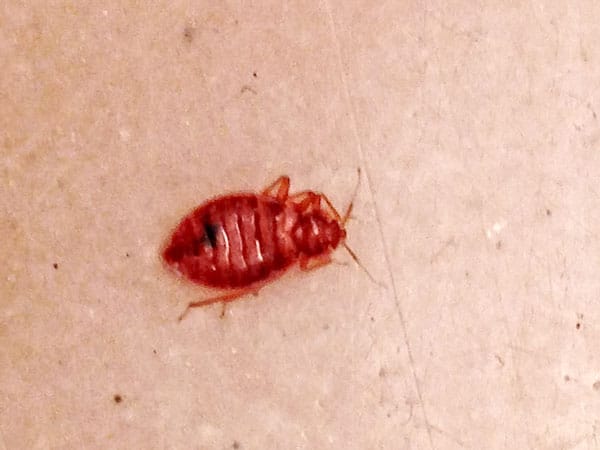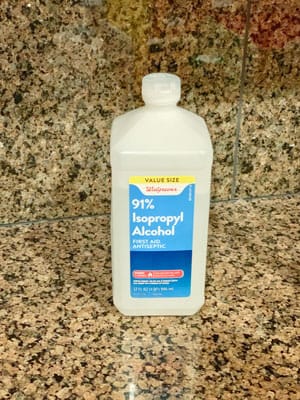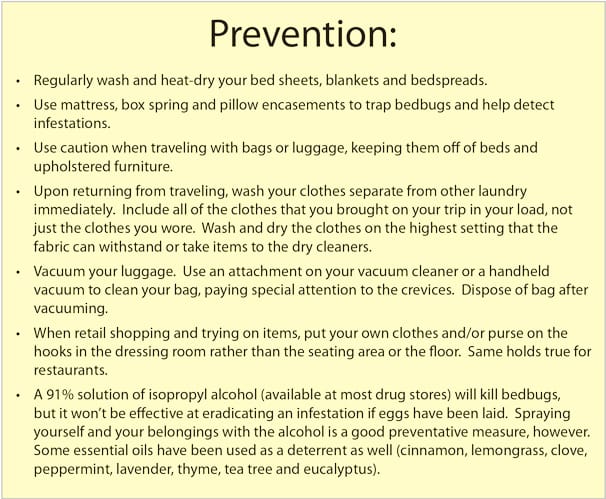What bites about bedbugs

Bedbugs generally have flat bodies and are brownish in color. After feeding, their bodies swell and become a reddish color, as pictured above.

Article and photos by Terri Wiebold
Well, pretty much everything bites about having bedbugs! Yes, I can speak to this first-hand, having just completed a full remediation in my own house.
Close encounter of the unwelcome kind: It all started with the sighting of one small bug on the sheets of my daughter’s bed. Our initial internet search of photos revealed that this critter was likely a Cimex lectularius, aka “bedbug.” A visit from a local exterminator confirmed our suspicions and unleashed a whole new set of challenges, not the least of which was overcoming the stigma that we had “cooties” or that our house somehow lacked cleanliness – neither of which proved to be true.
Disclaimer: I am by no means a scientist or an expert; I have had the unfortunate responsibility of quickly educating myself on the who, what, when, where and why of bedbugs. There is an abundance of information available online for those who are looking (most of my statistical research was on the Environmental Protection Agency (EPA) website: www.epa.gov/). For some reason – likely the cooties theory mentioned above, this is not something that is discussed openly or frequently among friends. Let’s get past that.
History: Bedbugs were first introduced in historical literature as far back as the Roman and Greek ages, dating more than 2,500 years ago and are even mentioned in the Talmud and New Testament of the Bible.
Bedbugs had all but been eradicated from the U.S. in the 1940s to the 1970s, when the use of the particular chemicals (DDT for example) were still legal. Now that many pesticides and chemicals are banned and international travel is on the rise, bedbugs seem to have reemerged and are spreading.
On closer inspection: Bedbugs are small, oval-shaped nocturnal insects that make their homes in the seams of mattresses, cushions, pillows and other linens and live on the blood of animals or humans, although they prefer humans. Adult bedbugs average 5 mm (about the size of a small lemon seed), have flat bodies and are brownish in color. After feeding, their bodies swell and become a reddish color. Most people are asleep when they get bit but wake to a series of small red bumps, often in a row. Before a bedbug draws your blood, it injects you with a substance that prevents you from feeling the bite.
A ticket to ride: Bedbugs are best thought of as “hitchhikers” because they move from place to place by attaching themselves to people’s personal belongings. These pests do not have wings, nor do they fly, but they are swift crawlers and can quickly make their way into a person’s pant cuff, shoe, bag, coat, or other item that has been placed on the floor or on a bed. They are especially successful at spreading from place to place by getting into purses, suitcases, or other belongings that people are traveling with.
Common places to pick up one of these pesky hitchhikers include hotels/motels, nursing homes, schools and day care centers, office buildings, shared housing like apartments or college dorms, hospitals or doctor’s offices, movie theaters or venues for public transportation.
Dispelling the misconceptions: First and foremost I feel the need to emphasize that bedbug habitats have nothing to do with the cleanliness of the surroundings. They can be found in five-star hotels just as easily as in homeless shelters – they do not discriminate, they just desire a food source (you) and a dark, discrete textile hiding place. Although they typically eat every five to 10 days, bedbugs can be quite resilient; they are capable of surviving several months to a year without feeding.
On the bright side: If there is such a thing, it would be that bedbugs are not known for transmitting disease.
Saying goodbye to unwelcome guests: The EPA recommends using a combination of both a chemical and non-chemical (heat) approach for eliminating bedbugs. Bedbugs die when their body temperatures reach 45°C (113°F). For an integrated pest management solution, estimate roughly $1 per square foot for remediation.

A 91% solution of isopropyl alcohol has proven to be effective in killing bedbugs.

So, several thousand dollars later and more than 30 loads of laundry in a matter of a few days, I am on the recovering side of remediation. Every drawer in every dresser was emptied; all cosmetics, candles, cleaning supplies and anything that couldn’t withstand the high temperatures (including fine art, plasma TVs and all live plants) were boxed up and removed; rooms were piled high with giant bags stuffed with clothing; and an entire day was spent away from the house with my dog in tow.
I am choosing to look at this as an educational experience and an opportunity to organize, clean and go through my closet. Doesn’t mean it was fun … or cheap!
I can now say with complete confidence that I (no longer) have bedbugs in my house; can you say the same?